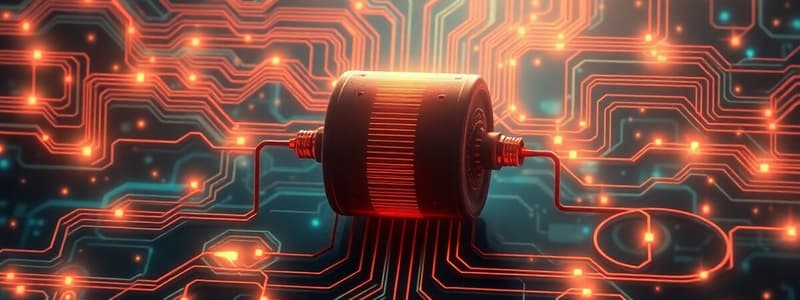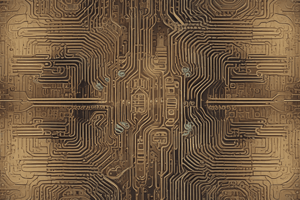Podcast
Questions and Answers
What condition defines resonance in both series and parallel AC circuits?
What condition defines resonance in both series and parallel AC circuits?
- The current is at its minimum.
- The inductive reactance equals the capacitive reactance. (correct)
- The voltage is at its maximum.
- The resistance is at its maximum.
In a series RLC circuit at resonance, what is the phase angle between the voltage and the current?
In a series RLC circuit at resonance, what is the phase angle between the voltage and the current?
- Zero degrees, voltage and current are in phase. (correct)
- 180 degrees, voltage and current are in opposite phase.
- 90 degrees, with current leading the voltage.
- 90 degrees, with voltage leading the current.
What is the total opposition to current flow in an AC circuit called?
What is the total opposition to current flow in an AC circuit called?
- Reactance
- Admittance
- Resistance
- Impedance (correct)
Which condition defines the resonant frequency ($f_0$) in an RLC circuit?
Which condition defines the resonant frequency ($f_0$) in an RLC circuit?
Flashcards
Impedance (Z)
Impedance (Z)
The total opposition to current flow in an AC circuit, including both resistance and reactance.
Reactance (X)
Reactance (X)
Opposition to current flow due to inductance (XL) or capacitance (XC) in an AC circuit.
Resonant Frequency (f₀)
Resonant Frequency (f₀)
The frequency at which inductive reactance (XL) equals capacitive reactance (XC).
Quality Factor (Q)
Quality Factor (Q)
Signup and view all the flashcards
Bandwidth (BW)
Bandwidth (BW)
Signup and view all the flashcards
Resonance
Resonance
Signup and view all the flashcards
Series Resonance
Series Resonance
Signup and view all the flashcards
Q Factor
Q Factor
Signup and view all the flashcards
Bandwidth (BW) in Series Resonance
Bandwidth (BW) in Series Resonance
Signup and view all the flashcards
Parallel Resonance
Parallel Resonance
Signup and view all the flashcards
Bandwidth (BW) in Parallel Resonance
Bandwidth (BW) in Parallel Resonance
Signup and view all the flashcards
Resistance (R)
Resistance (R)
Signup and view all the flashcards
Study Notes
- Resonance in AC circuits occurs when the inductive and capacitive reactances are equal, leading to unique circuit behaviors.
Series Resonance
- Series resonance happens in RLC series circuits when the inductive reactance (XL) equals the capacitive reactance (XC).
- At resonance, the impedance of the circuit is at its minimum and equal to the resistance (R).
- The circuit current is at its maximum (I = V/R, where V is the source voltage).
- The phase angle between voltage and current is zero, meaning the voltage and current are in phase.
- The resonant frequency (f₀) is determined by the formula: f₀ = 1 / (2π√(LC)).
- At resonance, the voltage across the inductor (VL) and the voltage across the capacitor (VC) can be significantly larger than the source voltage.
- The Q factor (Quality factor) indicates the sharpness of the resonance.
- The Q factor is defined as the ratio of the reactive power to the resistive power, or VL/V or VC/V at resonance.
- A higher Q factor implies a narrower bandwidth and a sharper resonance peak.
- Bandwidth (BW) is the range of frequencies for which the current is equal to or greater than 70.7% of the resonant value; BW = R/L.
- Applications of series resonance include tuning circuits in radios and impedance matching.
Parallel Resonance
- Parallel resonance occurs in RLC parallel circuits, also when XL = XC.
- At resonance, the impedance of the circuit is at its maximum.
- The circuit current from the source is at its minimum.
- The phase angle between voltage and current is zero, with voltage and current in phase.
- The resonant frequency (f₀) is the same as in series resonance: f₀ = 1 / (2π√(LC)).
- At resonance, the current circulating between the inductor and capacitor can be much larger than the source current.
- The Q factor in parallel resonance is also a measure of the sharpness of resonance.
- In an ideal parallel resonant circuit (no resistance), the Q factor would be infinite.
- For a parallel RLC circuit, Q can be expressed as R/XL or R/XC at resonance
- Bandwidth (BW) is the range of frequencies for which the impedance is equal to or greater than 70.7% of the resonant value; BW = 1/(RC)
- Applications include impedance matching, filter circuits, and oscillator circuits.
Key Parameters
- Resistance (R): The opposition to current flow, causing energy dissipation in the form of heat.
- Inductance (L): The property of a circuit element to oppose changes in current, storing energy in a magnetic field.
- Capacitance (C): The property of a circuit element to oppose changes in voltage, storing energy in an electric field.
- Impedance (Z): The total opposition to current flow in an AC circuit, including resistance and reactance.
- Reactance (X): The opposition to current flow due to inductance (XL) or capacitance (XC).
- Resonant Frequency (f₀): The frequency at which XL = XC.
- Quality Factor (Q): A dimensionless parameter indicating the sharpness of the resonance.
- Bandwidth (BW): The range of frequencies around the resonant frequency where the circuit's response is significant.
Calculations
- Inductive Reactance: XL = 2πfL, where f is the frequency and L is the inductance.
- Capacitive Reactance: XC = 1 / (2πfC), where f is the frequency and C is the capacitance.
- Impedance in Series RLC Circuit: Z = √(R² + (XL - XC)²)
- Impedance in Parallel RLC Circuit: Z = 1 / √( (1/R)² + (1/XL - 1/XC)² )
- Resonant Frequency: f₀ = 1 / (2π√(LC))
- Q factor (series): Q = XL/R = VC/VR = VL/VR
- Q factor (parallel): Q = R/XL = current circulating in L or C / Source current
- Bandwidth (series): BW = R/L
- Bandwidth (parallel): BW = 1/(RC)
Applications of Resonance
- Radio tuning circuits use resonance to select a specific frequency signal.
- Oscillator circuits rely on resonance to generate signals at a specific frequency.
- Filters use resonance to pass or reject specific frequencies.
- Inductive heating utilizes resonance to generate heat in conductive materials.
- Impedance matching networks use resonance to maximize power transfer.
Studying That Suits You
Use AI to generate personalized quizzes and flashcards to suit your learning preferences.



